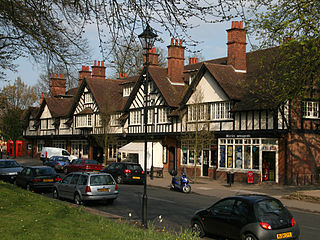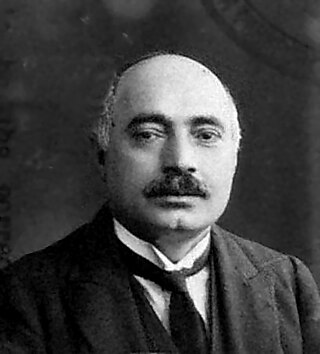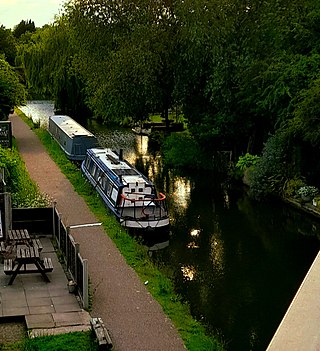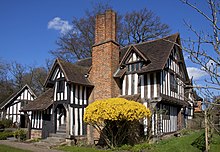A semi-detached house is a single family duplex dwelling house that shares one common wall with the next house. The name distinguishes this style of house from detached houses, with no shared walls, and terraced houses, with a shared wall on both sides. Often, semi-detached houses are built in pairs in which each house's layout is a mirror image of the other's.

Bournville is a model village on the southwest side of Birmingham, England, founded by the Quaker Cadbury family for employees at its Cadbury's factory, and designed to be a "garden" village where the sale of alcohol was forbidden. Cadbury's is well known for chocolate products – including a dark chocolate bar branded Bournville. Historically in northern Worcestershire, it is also a ward within the council constituency of Selly Oak and home to the Bournville Centre for Visual Arts and the Cadbury's chocolate factory. Bournville is known as one of the most desirable areas to live in the UK; research by the Joseph Rowntree Foundation in 2003 found that it was "one of the nicest places to live in Britain".

Northfield is a residential area in outer south Birmingham, England, and near the boundary with Worcestershire, which it was historically within. It is also a council constituency, managed by its own district committee. The constituency includes the wards of Kings Norton, Longbridge, Weoley Castle and the smaller ward of Northfield that includes West Heath and Turves Green.

Selly Oak is an industrial and residential area in south-west Birmingham, England. The area gives its name to Selly Oak ward and includes the neighbourhoods of: Bournbrook, Selly Park, and Ten Acres. The adjoining wards of Edgbaston and Harborne are to the north of the Bourn Brook, which was the former county boundary, and to the south are Weoley, and Bournville. A district committee serves the four wards of Selly Oak, Billesley, Bournville and Brandwood. The same wards form the Birmingham Selly Oak constituency, represented since 2010 by Steve McCabe (Labour). Selly Oak is connected to Birmingham by the Pershore Road (A441) and the Bristol Road (A38). The Worcester and Birmingham Canal and the Birmingham Cross-City Railway Line run across the Local District Centre.

George Cadbury was an English Quaker businessman and social reformer who expanded his father's Cadbury's cocoa and chocolate company in Britain.

Stirchley is a suburb in south-west Birmingham, England. The name likely refers to a pasture for cattle. The settlement dates back to at least 1658. Prehistoric evidence, Roman roads, and Anglo-Saxon charters contribute to its history. The Worcester and Birmingham Canal and the railways brought industry to the area. Stirchley's development is also linked to industries like screw-making and rubber manufacturing. Originally part of Worcestershire, Stirchley underwent administrative changes in 1911. Residential developments were established alongside the long-standing Victorian terracing which is associated with the suburb.

Although Birmingham in England has existed as a settlement for over a thousand years, today's city is overwhelmingly a product of the 18th, 19th, and 20th centuries, with little surviving from its early history. As it has expanded, it has acquired a variety of architectural styles. Buildings of most modern architectural styles in the United Kingdom are located in Birmingham. In recent years, Birmingham was one of the first cities to exhibit the blobitecture style with the construction of the Selfridges store at the Bullring Shopping Centre.

William Alexander Harvey was an English architect. He is most notable for his design of Bournville, the model 'garden suburb' built by Cadburys to house their chocolate-making workforce to the south of Birmingham.

Bournbrook is an industrial and residential district in southwest Birmingham, England, in the ward of Bournbrook and Selly Park and the parliamentary constituency of Birmingham Selly Oak. Before 2018 it was in Selly Oak Council Ward. Prior to what is commonly termed the Greater Birmingham Act, which came into effect on 9 November 1911, the Bourn Brook watercourse was the North Eastern boundary of Worcestershire, and the area was locally governed by the King's Norton and Northfield Urban District Council.
Minworth is a village situated in the civil parish of Sutton Coldfield, West Midlands, within Minworth there are three hamlets Wiggins Hill, Peddimore and The Greaves. Minworth lies within the City of Birmingham on its northeastern outer fringe, where it forms part of the Sutton Walmley and Minworth electoral ward and borders the North Warwickshire district, some 4.5 miles southeast of Sutton Coldfield town centre.

Wiggins Hill is a hamlet situated in the Minworth area of the civil parish of Sutton Coldfield, West Midlands. It lies within the City of Birmingham on its northeastern outer fringe, where it forms part of the Sutton Walmley and Minworth electoral ward and borders the North Warwickshire district.

Alphonse Mingana was an Assyrian theologian, historian, Syriacist, orientalist and a former priest who is best known for collecting and preserving the Mingana Collection of ancient Middle Eastern manuscripts at Birmingham. Like the majority of Assyrians in the Zakho region, his family belonged to the Chaldean Catholic Church. Alphonse was born to Paolus and Maryam Nano, and had seven siblings.

King's Norton and Northfield Urban District was a local government administrative district in north Worcestershire, England, from 1898 until 1911. Much of its area was afterwards absorbed into the neighbouring Borough of Birmingham, under the Greater Birmingham Scheme, and now constitutes most of the city's southern and southwestern suburban environs.

Dame Elizabeth Mary Cadbury was a British activist and philanthropist. Her husband was George Cadbury, the chocolate manufacturer.
The Birmingham West Suburban Railway was a suburban railway built by the Midland Railway company. Opened in stages between 1876 and 1885, it allowed both the opening of development of central southwest suburban Birmingham south into Worcestershire and the by-passing of railway traffic via the Birmingham and Gloucester Railway into central Birmingham. Today, it forms a major section of the Cross-City Line, running from Lichfield to Redditch. It also forms an important part of the Cross Country Route.

Northfield Manor House is a Manor House, on Bristol Road South, Northfield, Birmingham, England. It was formerly known as Manor Farm, and under that name was home to George and Elizabeth Cadbury.

Minworth Greaves is a timber cruck-framed, Grade II listed building in Bournville, an area of Birmingham, England. It is thought to date from the 14th-century or earlier, possibly as early as 1250. It is owned by the Bournville Village Trust. Minworth Greaves is situated next to Selly Manor, and is run as part of Selly Manor Museum. It was originally built in Minworth, near Sutton Coldfield to the North of Birmingham. After falling into extreme disrepair, it was purchased by George Cadbury and re-built by Laurence Cadbury in 1932 in the grounds of Selly Manor.
The Mingana Collection of Middle Eastern manuscripts, comprising over 3,000 documents, is held by the University of Birmingham's Cadbury Research Library.

Sutton Walmley and Minworth is one of 69 electoral wards in Birmingham, England.

















